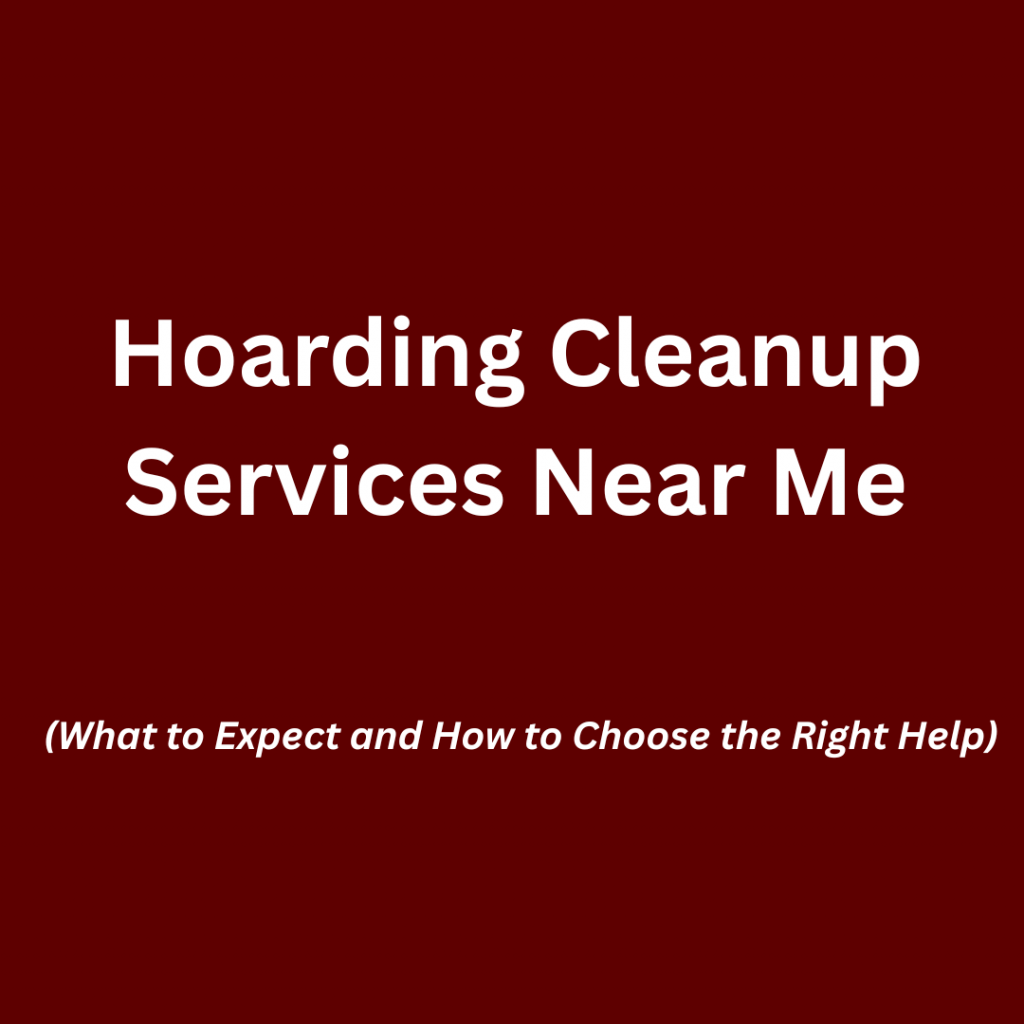Topic Summary
Hoarding cleanup is a step-by-step process that involves removing excessive clutter, eliminating biohazards, deep cleaning, and disinfecting the home to make it safe and livable again. This guide explains how to clean after hoarding, when to hire professionals, and how to choose the best “hoarding cleanup near me” service. It also covers costs, timelines, and emotional considerations to help you make the right decision.

The Story: Mary’s Home and the Hidden Danger
Mary’s home wasn’t always like this. Years ago, she was a neat, organized woman who loved hosting her grandkids. But after her husband passed, she found comfort in keeping things, mail, newspapers, clothes, kitchen gadgets, anything that reminded her of better times. Over the years, the clutter grew into towering piles.
One summer afternoon, a small kitchen fire started from a faulty toaster. The firefighters struggled to get inside because boxes blocked the doorway. Luckily, Mary survived, but her home was left covered in smoke, soot, and spoiled food.
Her daughter tried to help clean, but the smell, mold, and pests made it impossible. The emotional weight of deciding what to keep and what to throw away was too much. Eventually, they hired a professional hoarding cleanup service. In just a week, the house was safe, clean, and organized and Mary could breathe (literally and emotionally) again.
The lesson? Hoarding cleanup is more than cleaning, it’s a step toward restoring safety, dignity, and peace of mind.
What Is Hoarding and Why Is It Dangerous?
Hoarding is not just being messy or disorganized, it’s a mental health disorder where individuals have persistent difficulty parting with possessions, regardless of their actual value.
Dangers of hoarding include:
- Fire hazards: Paper, fabric, and clutter make fires spread quickly.
- Blocked exits: In an emergency, escape routes are inaccessible.
- Structural damage: Heavy piles can weaken floors and walls.
- Health risks: Mold, bacteria, and pests thrive in cluttered spaces.
- Air quality issues: Dust, allergens, and foul odors accumulate.
In severe cases, city officials can declare a home uninhabitable until it is cleaned.
How to Clean and Disinfect a Home After Hoarding

Cleaning after hoarding requires organization, safety precautions, and sometimes professional help. Here’s the process:
1. Prepare and Assess the Home
Before touching anything:
- Walk through the home and identify hazards like mold, animal waste, or structural issues.
- Decide whether this can be a DIY cleanup or requires professional help.
- Take photos for insurance purposes if damage is involved.
2. Gather Protective Gear
Never clean a hoarder’s home without protection. You may need:
- N95 respirator or mask (to block mold spores and dust)
- Heavy-duty gloves (to prevent cuts or contamination)
- Safety glasses
- Coveralls or old clothes you can discard afterward
- Sturdy boots to avoid injury from sharp objects
3. Create a Sorting System
The Four-Box Method works well:
- Keep – Items that are clean, functional, and truly needed.
- Donate – Things in good condition someone else can use.
- Recycle – Paper, glass, plastic, and metal.
- Trash – Broken, contaminated, or expired items.
Tip: Work one room at a time to avoid feeling overwhelmed.
4. Remove Trash and Clutter Safely
- Start with clear pathways for safety.
- Use heavy-duty trash bags or rent a dumpster.
- Lift small loads to avoid back injury.
- Watch out for needles, chemicals, or sharp metal.
5. Deep Clean and Disinfect
After clutter is gone:
- Vacuum with a HEPA filter to trap allergens.
- Wash surfaces with hot, soapy water.
- Disinfect with an EPA-approved cleaner to kill germs.
- Shampoo carpets or replace if heavily soiled.
- Deodorize with natural solutions or commercial odor removers.
6. Address Hidden Problems
Hoarding often hides:
- Mold growth (needs professional remediation)
- Pest infestations (requires exterminators)
- Structural issues (cracked walls, sagging floors)
- Plumbing leaks from neglected maintenance
7. Restore and Organize
- Repair damaged walls, floors, or windows.
- Install shelving and labeled storage bins.
- Create a maintenance plan to prevent relapse.
- Involve the homeowner in decisions to build trust.
DIY vs. Professional Hoarding Cleanup
Not every hoarding case needs professionals, but severe or hazardous cases do.
DIY cleanup works when:
- The clutter is moderate
- There are no biohazards
- The homeowner is emotionally ready to participate
Professional cleanup is necessary when:
- Biohazards (human waste, blood, mold) are present
- There’s a pest infestation
- The home is structurally unsafe
- The situation is emotionally overwhelming
How to Find the Best Hoarding Cleanup Service Near Me
When typing “hoarding cleanup near me” into Google, you’ll see many options but not all are equal.

Here’s what to look for:
1. Experience and Credentials
- Check for IICRC or OSHA certifications
- Ask how many hoarding cases they’ve handled
- Experience with biohazard cleanup is a plus
2. Comprehensive Services
A good company should offer:
- Clutter removal
- Biohazard disposal
- Mold remediation
- Odor removal
- Sanitization and disinfection
3. Compassionate Approach
Hoarding involves deep emotional attachment to possessions. The best companies:
- Work discreetly to protect privacy
- Allow the homeowner to participate in decisions
- Offer emotional support resources
4. Transparent Pricing
- Get a written estimate after an inspection
- Avoid vague “starting at” prices without details
- Ask if disposal fees are included
5. Good Reviews
Check:
- Google reviews for customer experiences
- BBB ratings for trustworthiness
- Before-and-after photos if available
Need Immediate Hoarding Cleanup in Columbus, Ohio?
Call PuroClean Home Savers now at (614) 689-0012. for fast, discreet, and reliable service.
With over 15 years of experience in hoarding cleanup and property restoration, our compassionate and certified team has helped countless Columbus, Ohio homeowners and families restore safe, livable environments.
We’re proud to have earned 100+ five-star reviews on Google, reflecting our dedication to professionalism, safety, and respect for our clients’ privacy.
Read our verified customer reviews here and see why Columbus, Ohio trusts PuroClean for hoarding cleanup and restoration.
Costs and Timelines
Average cost: $1,000–$10,000+
Factors affecting cost:
- Size of the home
- Amount of clutter
- Presence of biohazards
- Need for repairs
Average time:
- Light cleanup – 1–2 days
- Severe cases – 1–3 weeks
FAQs About Hoarding Cleanup Near Me
Q1: Can hoarding cleanup services work without me being there?
Yes, but they will need legal permission or proof of ownership.
Q2: Will insurance cover hoarding cleanup?
Sometimes. Check with your homeowners or renters policy.
Q3: How do I convince a loved one to accept cleanup help?
Approach with empathy, avoid shaming, and suggest professional help as a safety solution, not a judgment.
Q4: Are hoarding cleanup crews discreet?
Reputable companies arrive in unmarked vehicles to protect privacy.
Final Thoughts
Cleaning and disinfecting after hoarding is more than a physical task, it’s an emotional journey. Whether you tackle it yourself or hire a professional, the goal is to restore safety, dignity, and comfort.
If you search “hoarding cleanup near me”, choose a company with experience, compassion, and the ability to handle everything from trash removal to full restoration. The right help can turn an overwhelming challenge into a fresh start.


 PuroClean Home Savers
PuroClean Home Savers